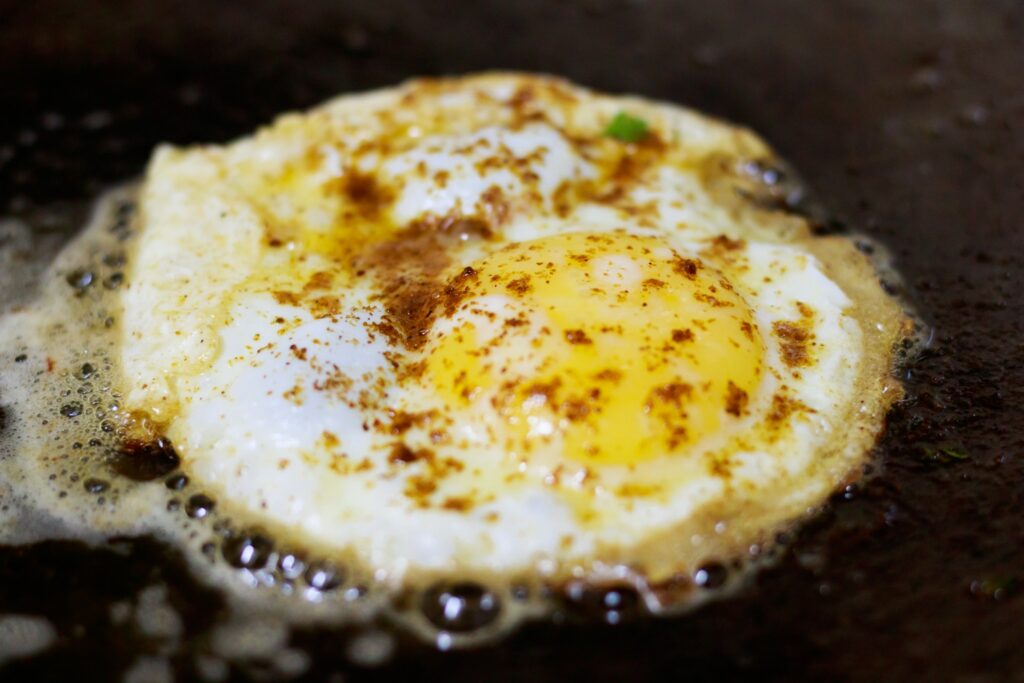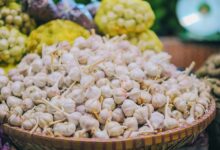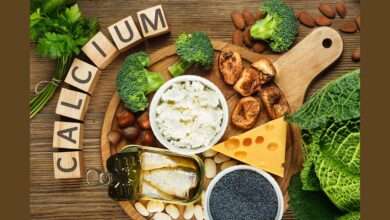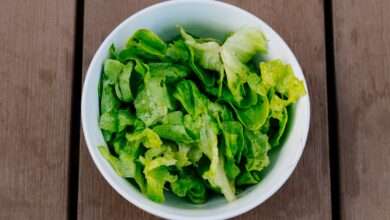
In recent years, nutrition experts have faced a dilemma: whether to limit the consumption of eggs, given their high cholesterol content, or to recommend them, given their high content of high-quality protein as well as in several vitamins and minerals. Today, there is no longer any restriction on egg consumption in healthy subjects. On the contrary, it is considered more of a health ally accessible to all and essential in the kitchen.
Egg characteristics
- Excellent source of protein;
- Source of choline and carotenoids;
- Source of cholesterol;
- Rich in vitamins and minerals;
- Good source of fat.
Nutritional and caloric values of egg
| What is a “portion” of an egg worth ? | |
| volume/weight | 2 eggs , medium size, 100 g |
| Calories | 140 |
| Proteins | 12,7 g |
| Carbohydrates | 0,27 g |
| Lipids | 9,83 g 100% of the lipids are found in the yolk of the egg. |
| Dietary fiber | 0,0 g |
Focus on the micronutrients contained in the egg
Among the nutrients contained in the egg in good quantity, we can mention the following:
- Selenium: the egg is an excellent source of selenium. This mineral works with one of the main antioxidant enzymes, preventing the formation of free radicals in the body. It also helps convert thyroid hormones into their active form;
- Vitamin B2: the egg is a good source of vitamin B2. This vitamin is also known as riboflavin. Like vitamin B1, riboflavin plays a role in the energy metabolism of all cells. In addition, it contributes to the growth and repair of tissues, the production of hormones and the formation of red blood cells. Most riboflavin is found in egg white;
- Vitamin B12: Eggs are a good source of vitamin B12. This vitamin works together with folic acid (vitamin B9) for the production of red blood cells. It also ensures the maintenance of nerve cells and cells that make bone tissue;
- Phosphorus: the egg is a source of phosphorus. Phosphorus is the second most abundant mineral in the body after calcium. It plays an essential role in the formation and maintenance of healthy bones and teeth. In addition, it participates, among other things, in the growth and regeneration of tissues and helps to maintain normal blood pH. Finally, phosphorus is one of the constituents of cell membranes;
- Zinc: the egg is a source of zinc. Zinc participates in particular in immune reactions, in the production of genetic material, in the perception of taste, in wound healing and in the development of the foetus. Zinc also interacts with sex and thyroid hormones, and participates, in the pancreas, in the synthesis (production), storage and release of insulin;
- Pantothenic acid: the egg is a source of pantothenic acid. Also called vitamin B5, pantothenic acid is part of a key coenzyme allowing us to properly use the energy present in the food we eat. It also participates in several stages of the synthesis (production) of steroid hormones, neurotransmitters (messengers in nerve impulses) and hemoglobin;
- Folate: Egg is a source of folate. Folate (vitamin B9) is involved in the production of all cells in the body, including red blood cells. This vitamin plays an essential role in the production of genetic material (DNA, RNA), in the functioning of the nervous system and the immune system, as well as in the healing of wounds and wounds. As it is necessary for the production of new cells, adequate consumption is essential during periods of growth and for the development of the fetus;
- Vitamin A: the egg is a source of vitamin A. This vitamin is one of the most versatile, playing a role in several functions of the body. It promotes, among other things, the growth of bones and teeth. It keeps the skin healthy and protects against infections. In addition, it plays an antioxidant role and promotes good vision, especially in the dark. Most vitamin A is found in the egg yolk;
- Vitamin D: the egg is a source of vitamin D. Vitamin D interacts closely in the health of bones and teeth, by making calcium and phosphorus available in the blood, among other things for the growth of the bone structure. Vitamin D also plays a role in the maturation of cells, including those of the immune system. Most vitamin A is found in the egg yolk;
- Vitamin E: the egg is a source of vitamin E. A major antioxidant, vitamin E protects the membrane that surrounds the cells of the body, in particular red blood cells and white blood cells (cells of the immune system).
- bridge
- Allergies (overview)
- Achluophobia : all about the fear of the dark
- At what age can you do bodybuilding?
- Fatigue in the morning: causes and remedies
The benefits of egg
Recent scientific data tends to show that the egg is a food of choice and that the consumption of an egg per day, even in people with high blood cholesterol, may be acceptable. Indeed, there is no substantial evidence showing a real association between the consumption of dietary cholesterol and blood cholesterol levels. The egg is nutritious, versatile and offers excellent nutritional value at a low cost.
A perfect protein profile
The egg is composed of proteins of high biological value. Protein is primarily used to build, repair and maintain healthy tissues, such as skin, muscle and bone. They are also used in the formation of digestive enzymes and hormones. The proteins contained in the egg are said to be complete because they contain the nine amino acids essential to the body, and this, in optimal proportions.
Indeed, the protein quality of the egg is such that it is used as a reference food to assess the quality of other food proteins. Note that amino acids are said to be essential when the body cannot produce them. They must therefore come from food. Nearly 60% of egg protein is found in the white while the remaining 30% is in the yolk.
Carotenoid content
Egg yolk contains two powerful antioxidants from the carotenoid family: lutein and zeaxanthin. Moreover, these two compounds give color to the yolk of the egg. Carotenoids, substances similar to vitamin A, are antioxidants known to help prevent diseases related to aging, such as cataracts, macular degeneration, cardiovascular diseases and certain cancers.
These antioxidants neutralize or reduce the free radicals present in the body and thus limit the damage caused to the cells. Observational studies indicate that eating lutein-rich foods, such as eggs, may help prevent age-related macular degeneration, one of the leading causes of blindness in people aged 65 and over. , and reduce the risk of cataracts. The possible role of carotenoids in the prevention of cardiovascular diseases (CVD) would be to reduce the oxidation of LDL-cholesterol (“bad cholesterol”) and to reduce the formation of plaque in the walls of the arteries.
Finally, carotenoids could reduce the risk of certain cancers by protecting them against the development of tumours. Data from a prospective study, the Nurses’ Health Study, involving 83,234 nurses demonstrated that the higher the intake of lutein and zeaxanthin, the lower the risk of breast cancer in perimenopausal women.
Source of choline
Egg is an excellent source of choline, a compound that plays an important role in the development and functioning of the brain, primarily the memory center. Choline is mainly found in the yolk part of the egg. Choline requirements are important during embryonic development since during pregnancy and lactation, low choline intakes can have long-term effects on the child’s brain development. A study in animals has shown that choline supplementation, during the embryonic development of rats or immediately after birth, improves cognitive functions and, by extension, attention and memory.
In addition, authors have reported, in a study carried out among pregnant women with low intakes of folic acid, that mothers who had the lowest choline intakes were four times more likely to give birth to a child with a neural tube defect than those with the highest intakes, regardless of folic acid intake.
Egg and cholesterol: what should we think?
Since it is now known that high blood cholesterol levels are associated with an increased incidence of cardiovascular disease (CVD), most nutritional recommendations for the treatment of these diseases aim to reduce the consumption of foods high in cholesterol and thus limit egg yolks to two or three per week.
However, these recommendations have been questioned since many studies observe a weak relationship between dietary cholesterol and the incidence of cardiovascular disease. It seems that a consumption as high as one egg per day has no significant impact on cardiovascular risk. A prospective study in 117,000 healthy men and women found no significant link between egg consumption and cardiovascular disease. According to this study, the risk was not higher in those who consumed less than one egg per week than in those who consumed more than one per day.
Other studies, including a recent one, have shown that foods high in cholesterol but low in saturated fat such as egg yolks have minor effects on blood cholesterol levels. Several studies indicate that blood lipid control is better achieved by reducing the consumption of trans and saturated fats, rather than eliminating dietary cholesterol. Moreover, the American Heart Association (AHA) mentions that the consumption of one egg yolk a day may be acceptable, even for hypercholesterolemic people, if the consumption of other cholesterol-rich foods, such as cheeses, cream, butter and red meats, is limited.
Nutritionist’s word
If you have trouble digesting cooked eggs, the cause may be the fat you use to cook it, not the egg itself. For idea, a portion of egg corresponds to 2 units, or about 125g with the shell.

How to choose the right eggs?
The egg has been consumed by humans since prehistoric times. Today, we mainly eat chicken eggs, but that has not always been the case. Indeed, cane and goose eggs have long been an integral part of the diet, although less consumed at present. An egg weighs on average 60g with its shell, 55g without.
egg id card
- Origin: Europe and Asia;
- Season: available all year round;
- Color: white to beige;
- Flavor: pronounced.
Brown or white?
There is no difference in nutritional value or flavor between white-shelled and brown-shelled eggs. The color of the shell depends on the breed of the hen. Brown eggs, however, would have the thicker shell and the darker yolk.
Eggs enriched with Omega-3
Omega-3 eggs are identical to regular eggs in terms of total fat and cholesterol content. Only the omega-3 polyunsaturated fatty acid content of one differentiates it from the other. Omega-3 enriched eggs are produced by adding flaxseed to the hen’s diet. The latter is rich in alpha-linolenic acid (ALA), a type of omega-3 fatty acid.
An omega-3 egg covers 25% to 30% of our ALA needs, which can represent an additional supply of these fatty acids. Interestingly, some liquid egg products have been fortified with omega-3s from marine sources. Unlike ALA, these fats from marine sources do not require longer chain processing before being used for certain functions in the body. However, it is important to mention that the eggs of hens fed flaxseed also contain long-chain omega-3s, since the hen metabolizes part of the ALAs into EPA and DHA (two omega-3s found in abundance in fish bold).
Recognize a fresh egg
If you are unsure of the freshness of an egg, you can immerse it in a bowl of water. Since the air pocket is small in the fresh egg, it sinks to the bottom while resting on the side. Since its air pocket is larger, the aged egg floats with the large end facing upwards.
Tips to avoid food poisoning
Store eggs in the refrigerator at all times. All in all, they shouldn’t be kept out of the fridge for longer than two hours (including cooking time and serving). If the eggs must be at room temperature for a recipe, take them out half an hour in advance or reheat them in lukewarm water for a few minutes before using them.
To avoid the risk of cross-contamination, wash hands and clean kitchen utensils after handling meat and fish and before handling eggs (and vice versa). Do not use broken or cracked eggs, which may be contaminated. The occasional spot of blood in an egg poses no danger. You can remove it if you want with the tip of a knife.
For optimal preservation
- In the refrigerator: the whole egg in its shell can be kept for five weeks from the date of packaging (approximately 3 weeks after purchase) without noticeably losing quality. After this time, the flesh may dry out. Once the shell is removed, the whites and yolks will keep for two days. Hard-boiled eggs keep for an average of one week;
- In the freezer: the whites can be frozen separately for later use. Put them in the ice cube tray, freeze and transfer to a freezer bag. Thaw in the refrigerator, not at room temperature. To freeze the whole egg, thoroughly mix white and yolk before freezing in an airtight container. Do not freeze the whole egg because its shell bursts under the effect of the cold.
- To freeze the yolks, it is recommended to add the equivalent of a teaspoon and a half of sugar or corn syrup (for 4 eggs) if you plan to use them in a sweet preparation, or 1/8 of teaspoon of salt for other types of preparations. This treatment will prevent them from becoming lumpy when frozen.
Organic eggs?
There are now organic eggs on the market. These eggs are laid by free-range hens in open-air henhouses equipped with nests and perches. The hens are fed organic feed prepared to strict specifications. Organic egg producers are certified by an official body, which guarantees the consumer that these products meet organic farming standards.

How to prepare the eggs
In the kitchen, the egg is an essential ingredient and which allows the realization of a multitude of recipes on a daily basis. It is used for pastry as well as for the realization of basic and express recipes. Thanks to its excellent protein content and its low cost, it is the ally for simple, gourmet and nutritious cooking.
Cooking eggs
Since it is not recommended to consume raw eggs (even for classic preparations such as mayonnaise, soufflés and mousses), here is how to prepare them:
- Cooking yolks normally used raw in the kitchen: cook over low heat in a heavy-bottomed saucepan, adding about 2 tablespoons of water or other liquid per yolk. Stir continuously and cook until the mixture forms a thin film on a metal spoon, or until the internal temperature reaches 71ºC (160ºF). Place saucepan in ice water until mixture cools and use immediately;
- Cooking the whites used normally raw in the kitchen: cook them on a low heat in a bain-marie with 2 tablespoons of sugar, 1 tablespoon of water and 1/8 of a teaspoon of cream of tartar per white, in stirring continuously on low speed with a hand mixer until they reach an internal temperature of 71ºC (160ºF). Pour into a large bowl and beat on high speed until the mixture forms fluffy peaks. Then follow the recipe as normal.
The egg, an essential ingredient in French cuisine
If eggs are the basis of soufflés, flans, quiches or pancakes, here are some other suggestions for preparations:
- In salad. Serve the soft-boiled eggs on a salad of fine greens. Boiled eggs can be added to a vegetable salad of your choice, or in the Niçoise salad, with cubed potatoes, tomatoes, snow peas, tuna, olives and baby greens. Drizzle with a Dijon mustard vinaigrette. Or make a filling for a sandwich, adding parsley and chives or other fine herbs;
- Hard boiled eggs. Boil the eggs and cut them in half lengthwise. Remove the yolk that we will crush with mustard, mayonnaise, sour cream or yogurt, lemon juice, capers, salt and pepper and fill the whites with this mixture. Refrigerate before serving. You can vary by replacing the capers with minced olives and adding hot pepper or Tabasco sauce;
- Omelettes. Chives, watercress, parsley, tarragon and lemon balm go wonderfully with eggs;
- Marinated hard-boiled eggs. Put hard-boiled eggs in a jar. Heat vinegar and concentrated orange juice, a cinnamon stick and cloves in a saucepan for a few minutes. Pour over the eggs, close the jar and let cool to room temperature, then refrigerate. Wait at least a week, and up to three or four weeks, before consuming;
- Boiled egg, soft-boiled egg, hard-boiled egg. What is the difference ? In fact, only the cooking time varies. A soft-boiled egg is an egg whose white is starting to coagulate and whose yolk is still liquid. The soft-boiled egg is an egg whose white is solid but the yolk is still runny. Finally, the hard-boiled egg is an egg whose white and yolk are firm;
- The egg alone can also be poached, scrambled, fried or fried, fried or spun;
- Scrambled eggs. Add various ingredients to the eggs: grated cheese, diced tomatoes seasoned with basil, sour cream flavored with chives, pieces of canned sardines or anchovies, crab meat seasoned with curry, capers, pieces of bacon or sausage, mushrooms , finely cut vegetables, etc. ;
- Huevos Rancheros. Prepare a more or less spicy salsa according to your taste, pour it into an oven dish and dig “nests” in which you will place raw eggs. Garnish with strips of pimiento (bell pepper) and sprinkle with grated cheese. Bake until eggs are firm in oven set at 215°C (420°F);
- Florentine soup. Heat finely chopped spinach for a few minutes in chicken or vegetable broth to which nutmeg has been added. Add beaten eggs to this soup, stirring well. Immediately remove from heat. Serve in bowls, adding grated Parmesan cheese, if desired;
- Provencal omelet. First, cook five runny omelettes, the first with green onions, the second with spinach or another leafy green, the third with garlic, the fourth with tomato and the fifth with herbs. Stack them in order in a buttered or oiled round mold. Put the mold in the oven for about twenty minutes in a container half filled with water. Serve hot or cold, slicing to expose the various colors;
- Crunchy bread. Dip slices of bread in eggs beaten with milk, pan-fry and serve with maple syrup or brown sugar;
- Frittata or “western omelet”. Almost all countries have their own version of this preparation, which consists of sautéing vegetables (potatoes, tomatoes, zucchini, broccoli, spinach, depending on the season), mushrooms, diced ham or sausage, and other foods of his choice until cooked, and then pour over beaten eggs flavored with fine herbs and garnished with grated cheese. You can vary by adding pasta or oriental noodles, shrimp or smoked salmon, and dried tomatoes;
- Egg in the hole. Remove part of the crumb from a slice of bread. Put the latter to brown in a frying pan and break an egg into the opening. Cook until the white is firm and serve. You can do the same thing with slices of partially hollowed potatoes, which you will cook in the oven for about fifteen minutes.
Discover the Hundred Year Egg
A true classic of Chinese cuisine, the hundred-year-old egg is actually kept for only a few months in a mixture of saltpetre, tea leaves, clay and other materials which have the effect of coloring the shell in black and give the flesh a greenish color and the texture of a hard-boiled egg. They are usually thinly sliced and served as appetizers with other delicacies.

Contraindications and egg allergies
Eggs are among the allergenic foods responsible for more or less violent allergic reactions in certain sensitive subjects. Although egg allergy often improves with age, this is not always the case, so be very careful. In addition, the egg is a very fragile food, so it should be cooked with care to avoid food poisoning, the consequences of which can be very serious.
egg allergy
Eggs are, along with milk, peanuts and shellfish, one of the main causes of food allergies. Egg allergy is usually caused by the reaction of the immune system to one of the protein fractions contained in the egg white. However, in some people, it is the proteins contained in the egg yolk that cause the allergy. As it is impossible to separate egg yolk and egg white 100%, the only solution to avoid the allergic reaction is to exclude foods or products containing eggs or egg derivatives as well as foods likely to to have been in contact with eggs.
People allergic to raw eggs usually cannot eat cooked eggs. Although cooking alters the protein in a raw egg, it is not enough to prevent an allergic reaction. Fortunately, egg allergy disappears in the majority of children after the age of five. However, when the allergy is severe, it is likely to last a lifetime. As a preventive measure, egg white should not be introduced into the child’s diet before the age of one year.
The most common symptoms of egg allergy affect the gastrointestinal system (vomiting, diarrhea), the respiratory system (asthma, bronchitis) and are also often related to skin problems (eczema).
Risk of food poisoning
Egg safety is of primary importance, given the risks of contamination by bacteria or viruses (eg salmonella and the H5N1 virus). The Canadian Egg Marketing Agency has worked to improve the natural defenses of the egg (hard shell, two membranes and antimicrobial properties in the albumen), through the Start Clean – Stay Clean™ program, founded on a hazard management method. In Canada, in 2003 and 2004, the compliance rate of inspected egg products was 97% (3% of eggs were non-compliant or unsafe).
Although the risks of salmonella infection are minimal, to eliminate these risks, Health Canada recommends that consumers, primarily pregnant women, the elderly, very young children and people with weakened immune systems as a result of disease, to cook the eggs until the white and the yolk have a solid consistency. There are pasteurized liquid egg preparations on the market that can be used instead of raw eggs, since pasteurization has destroyed bacteria, including salmonella, that may be contained in the egg.

History and anecdotes
Before taking its final form in the 14th century, “egg” was written successively “of”, “uef” and “oef” in the 12th century. The word comes from the Latin ovum.
A little history
The eggs of various species of birds have undoubtedly been eaten since ancient times. The Phoenicians feasted on the eggs of the ostrich, while, in antiquity, the Romans ate those of the blue peacock and the Chinese, those of the pigeon. In fact, the eggs of any egg-laying species, including turtle and alligator, can be used as food.
However, over the course of evolution, the chicken egg has gradually taken precedence over all others, but this has happened rather recently. Although Apicius, a famous gastronome of Roman antiquity, gave various recipes for flans and omelettes in his culinary book, the egg will long remain a marginal food, partly because of religious prohibitions and beliefs superstitious, on the other hand for economic reasons: in fact, the people in general considered that it was much more profitable to wait for the egg to turn into a hen or a rooster. The exception to this rule was the Chinese, who considered it an excellent nutritional source and spread its use throughout eastern Asia.
There is no mention of the egg in the few writings available on the Middle Ages in Europe, perhaps because, like meat, it was forbidden by the Catholic Church to consume them on days lean, that is, for more than 160 days per year. However, the hens, which did not follow the liturgical calendar, but that of the seasons and their biological cycle, laid abundantly during Lent, a period when daylight was again abundant. To avoid losing this precious resource, they were kept in liquid fat or wax until Easter, the auspicious day par excellence.
To improve their appearance after their prolonged stay in the vault, they were decorated in various ways. This is how the tradition of Easter eggs was born. In the middle of the 17th century, we know of at least 60 recipes for preparing this food which appears more and more often on the menu.
Improve productivity
In the 18th century, the discovery by the French of an artificial brooding technique practiced by the Egyptians by using low-temperature ovens aroused the greatest interest among breeders, who multiplied crossbreeding. In the 19th century, distinctly more productive breeds of hens, selected by the Chinese, appeared in the West, creating a real stir among breeders who all wanted to own some of these “new” birds, very different from those of the breeds. known Mediterranean and European. During this century, a hundred other breeds will be created, some of which are raised only for the flesh, others for the eggs, others finally for both uses.
There followed a prosperous period for the egg which, until the 1980s, was considered the perfect food. However, its popularity will decrease when it is discovered that its yolk is particularly rich in cholesterol, accused of being the cause of cardiovascular disease. In this decade alone, sales of fresh eggs will drop by 25%. The multiplication of salmonellosis epidemics during the same period and until recently will further add to this fatality. It is therefore inadvisable to eat the raw egg, which until then appeared in many dishes, especially in mayonnaise. In recent years, the egg has regained some of its lost popularity, after various clinical studies have shown that, for the majority of the population, it constitutes a food of excellent quality.
In addition to fresh eggs, there are now on the market preparations based on dehydrated, liquid and frozen eggs (albumen alone, yolk alone, whole egg, albumen and yolk mixed in various proportions).
Ecology and environment
Until the Second World War, the egg will be mainly produced on small family farms, which have on average only 400 laying hens. Various innovations, especially in veterinary medicine and in the formulation of enriched feed, as well as the creation of complex mechanical equipment, would lead to battery farming as we know it today, with its hundreds of thousands, if not millions of hens per production unit. For example, in the United States, one of the largest producing countries in the world, 95% of production is ensured by 260 farms, of which 65 have more than one million hens and 9 have more than five million. In this country, the smallest farms have a minimum of 30,000 hens.
In these farms, the hens are, in most cases, confined to narrow cages in which they can barely move. They have no access to outside air or daylight, their production cycle being entirely controlled by artificial lighting. The conditions in which they live, in particular the large number of individuals in the same space, create in them a permanent state of stress which has the effect of weakening their immune system, which requires the administration of antibiotics.














